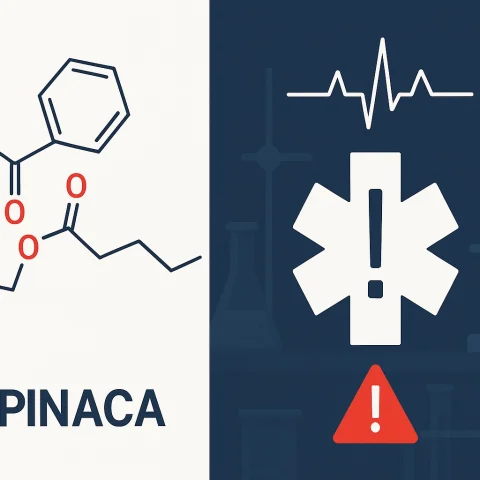- From Pfizer Labs to Street Deaths: Full Analysis
PINACA: The Deadly Synthetic Cannabis That Kills

Contents
Contents
PINACA: When Chemistry Gets Personal and Dangerous
December 12, 2023. Washington, D.C. The DEA Administrator issues an emergency scheduling order placing six synthetic cannabinoids into Schedule I, citing “imminent hazard to the public safety.” Among these compounds sits MDMB-4en-PINACA, the latest evolution of a chemical family that began with a simple pharmaceutical research project at Pfizer in 2009. What started as AB-PINACA, an experimental analgesic compound, has morphed into a generation of synthetic cannabinoids so potent and unpredictable that they’re redefining our understanding of designer drug dangers.
The journey from Pfizer’s laboratory benches to emergency rooms across America represents more than just another synthetic drug story – it’s a case study in how legitimate pharmaceutical research can be weaponized by underground chemists, creating compounds that are exponentially more dangerous than their original cannabis-mimicking predecessors. This is the story of PINACA: the synthetic cannabinoid that made chemists rethink everything they thought they knew about designer drugs, and why understanding its molecular deception is crucial for anyone seeking to comprehend the modern synthetic cannabinoid crisis.
PINACA Unveiled: The Technical Deep Dive
AB-PINACA’s full chemical designation—N-[(1S)-1-(Aminocarbonyl)-2-methylpropyl]-1-pentyl-1H-indazole-3-carboxamide—reveals the molecular sophistication that distinguishes it from earlier synthetic cannabinoids. PubChem’s molecular analysis shows the compound’s indazole core structure, representing a significant evolutionary leap from the indole-based cannabinoids that dominated the first generation of synthetic drugs.
Receptor Binding Profile
- • CB1 receptor: Ki = 2.87 nM
- • CB2 receptor: Ki = 0.88 nM
- • Full agonist activity at both receptors
- • 1.5x more potent than THC
Chemical Advantages
- • Indazole core provides metabolic stability
- • ACA (aminocarbonyl) designation indicates amide linkage
- • Enhanced lipophilicity improves brain penetration
- • Longer half-life than earlier synthetics
The “ACA” designation in PINACA’s name represents a critical structural feature that distinguishes it from predecessor compounds. This aminocarbonyl group creates an amide linkage that significantly enhances the compound’s metabolic stability, explaining why PINACA metabolites retain pharmacological activity long after the parent compound would typically be eliminated from the body.
⚠️ Potency Comparison Crisis
While natural THC requires milligram-level doses to produce effects, AB-PINACA achieves full cannabinoid receptor activation at nanogram concentrations. This 1000-fold increase in potency means that microscopic variations in dose—invisible to the naked eye—can be the difference between intoxication and life-threatening overdose.
Chemical stability testing reveals another alarming characteristic: unlike natural cannabinoids that degrade predictably over time, PINACA compounds maintain their potency for extended periods under normal storage conditions. This stability, combined with their extreme potency, creates a dangerous combination where products can remain hazardous long after purchase, with no visual indication of their cannabinoid content or concentration.
The Development Timeline: From Lab to Street
The story of PINACA begins in the legitimate pharmaceutical industry, highlighting how academic research can be corrupted for illicit purposes. Pfizer’s 2009 patent filing described AB-PINACA as part of a series of indazole-3-carboxamide compounds being investigated for their analgesic properties, with no intention of creating recreational drugs.
Geographic Emergence Patterns
Initial Detection
- • 2012: First European seizures
- • 2013: Appears in Japanese market
- • 2014: US forensic laboratories report cases
- • 2015: DEA emergency scheduling
Distribution Evolution
- • Head shops and gas stations
- • Online marketplace proliferation
- • Prison infiltration networks
- • International supply chain development
The transition from pharmaceutical research to street drug occurred through underground chemists who recognized the commercial potential of Pfizer’s published research. By 2012, AB-PINACA had appeared in European drug seizures, marking the beginning of a rapid global proliferation that would eventually lead to the current crisis of PINACA-derived compounds.
Key players in the synthesis and distribution network remain largely invisible due to the decentralized nature of synthetic cannabinoid production. However, law enforcement investigations have revealed sophisticated operations utilizing Chinese chemical suppliers, domestic application facilities, and retail distribution networks that span from traditional head shops to online marketplaces, creating a supply chain that has proven remarkably resilient to enforcement efforts.
Biological Impact and Mechanism: Why PINACA Is Exponentially More Dangerous
Unprecedented Receptor Activation
AB-PINACA’s pharmacodynamic profile reveals why it produces effects so dramatically different from natural cannabis. University of Arkansas research demonstrates that while AB-PINACA exhibits similar affinity for CB1 receptors as THC, it shows significantly greater efficacy for G-protein activation and higher potency for adenylyl cyclase inhibition, creating a biological response that bears little resemblance to natural cannabinoid effects.
Metabolic Profile Dangers
Active Metabolites
- • 4-OH-AB-PINACA retains full CB1 activity
- • 5-OH-AB-PINACA maintains receptor binding
- • Carboxylic acid metabolite remains detectable
- • Limited glucuronide formation
Tolerance Development
- • Greater CB1 receptor desensitization than THC
- • Rapid tolerance requiring dose escalation
- • Cross-tolerance complications
- • Persistent receptor downregulation
The most alarming aspect of PINACA’s biological profile is its production of pharmacologically active metabolites. Metabolic profiling studies reveal that AB-PINACA generates 23 distinct metabolites, with several retaining full agonist activity at cannabinoid receptors. This means that users experience prolonged effects as active metabolites continue to circulate long after the parent compound has been cleared from the system.
Cannabis Tolerance Irrelevance
Users with extensive natural cannabis tolerance experience no protection against PINACA’s effects. The compound’s full agonist activity at CB1 receptors bypasses the partial agonism that characterizes THC, meaning that even experienced cannabis users face unpredictable and potentially life-threatening responses to PINACA compounds.
Drug interaction profiles add another layer of complexity to PINACA’s biological impact. Unlike THC, which has well-documented interaction patterns, PINACA compounds can interact unpredictably with common medications, alcohol, and other recreational drugs, creating combination effects that are impossible to predict and extremely difficult to treat in emergency medical situations.
Real-World Consequences: Emergency Rooms and Human Cost
Emergency departments across the United States have documented a disturbing pattern of PINACA-related medical emergencies that bear no resemblance to typical cannabis-related presentations. Recent case series from New Jersey reveal the scope of synthetic cannabinoid emergencies, with 97% of patients presenting with altered mental status, 41% experiencing seizures, and 43% requiring intubation.
Clinical Presentation Patterns
Acute Symptoms
- • Altered mental status (97% of cases)
- • Tachycardia (57% of cases)
- • Seizures (41% of cases)
- • Respiratory depression (35% of cases)
- • Hypotension (41% of cases)
Treatment Challenges
- • ICU admission rate: 65%
- • Intubation requirement: 43%
- • Variable naloxone response
- • QTc prolongation: 27%
- • Cardiac complications
User experience reports consistently describe effects that diverge dramatically from expectations based on natural cannabis use. The unpredictability of PINACA effects has been documented in clinical settings where patients present with symptoms ranging from catatonic unresponsiveness to extreme agitation, often within the same intoxication episode, making medical management extremely challenging.
Long-term Health Impact Research
Emerging research suggests that PINACA exposure may cause lasting neurological changes that persist long after acute intoxication resolves. Studies document cases of persistent cognitive impairment, anxiety disorders, and psychotic symptoms that require ongoing psychiatric treatment, representing a hidden public health cost that is only beginning to be understood.
Geographic clustering of PINACA emergencies has revealed troubling patterns in vulnerable populations. Prison systems, homeless communities, and areas with limited access to traditional cannabis have experienced disproportionate impacts, suggesting that PINACA products often serve as dangerous substitutes in situations where safer alternatives are unavailable or prohibited.
Detection and Law Enforcement: The Analytical Challenge
Forensic detection of PINACA compounds represents one of the most challenging problems in modern analytical chemistry. Standard drug screening methods are completely ineffective for identifying synthetic cannabinoids, and even advanced LC-MS/MS systems struggle with the constant introduction of new PINACA variants that share similar mass spectra and fragmentation patterns.
Law Enforcement Adaptation
Operations targeting PINACA distribution networks require specialized training and equipment. The DEA’s emergency scheduling of six synthetic cannabinoids in 2023 reflects the rapid pace of chemical innovation that continues to outpace regulatory responses.
Looking Ahead: PINACA’s Legacy and BINACA’s Emergence
PINACA’s influence on synthetic cannabinoid development extends far beyond its own chemical family. The success of PINACA compounds in evading detection and regulation has established design principles that continue to influence next-generation synthetic cannabinoids, including the emerging BINACA series and other indazole-based compounds that represent the current frontier of synthetic cannabinoid development.
The transition from PINACA to newer compounds like BINACA and other synthetic cannabinoids demonstrates the persistent challenge of designer drug control, where each regulatory success simply accelerates the development of new compounds designed to circumvent existing laws while maintaining or increasing pharmacological potency.
Frequently Asked Questions About PINACA
What does PINACA stand for?
PINACA is derived from the compound’s structural features: “P” for pentyl chain, “IN” for indazole core, “A” for amide, “C” for carboxamide, and “A” for aminocarbonyl. The full name is N-[(1S)-1-(Aminocarbonyl)-2-methylpropyl]-1-pentyl-1H-indazole-3-carboxamide.
How much more potent is PINACA than THC?
AB-PINACA is approximately 1.5 times more potent than THC in terms of receptor binding, but its full agonist activity means it can produce maximal cannabinoid receptor activation at much lower doses. This creates a practical potency difference of potentially 100-1000 fold in terms of effects produced.
Can PINACA be detected in drug tests?
Standard drug screening tests cannot detect PINACA compounds. Advanced LC-MS/MS testing is required for identification, and even these methods require specific reference standards for each PINACA variant. Most routine drug tests will show negative results despite recent PINACA use.
What are the signs of PINACA overdose?
PINACA overdose symptoms include altered mental status, seizures, respiratory depression, extreme agitation followed by unresponsiveness, rapid heart rate, and potential cardiac complications. Unlike cannabis overdose, PINACA overdose can be life-threatening and requires immediate medical attention.
Is PINACA used in any legitimate research?
AB-PINACA was originally developed by Pfizer for legitimate pharmaceutical research into analgesic compounds. Current legitimate research focuses on understanding its toxicology, developing detection methods, and studying its pharmacological properties for public health purposes.
How is PINACA different from earlier synthetic cannabinoids?
PINACA compounds use an indazole core instead of the indole structure found in earlier synthetics like JWH compounds. This structural change provides greater metabolic stability, longer duration of action, and the production of active metabolites that extend the drug’s effects significantly beyond the parent compound’s elimination.
Important Health and Safety Information
This information is provided for educational purposes only and should not be considered medical advice. If you or someone you know is struggling with synthetic cannabinoid use, seek professional help immediately.
Emergency Contact Information: For immediate medical assistance, contact emergency services at 911 (US) or 112 (EU). PINACA overdoses require immediate medical attention as standard overdose treatments may not be effective for synthetic cannabinoid poisoning.
Addiction Resources: Contact SAMHSA’s National Helpline at 1-800-662-4357 for confidential, free, 24/7 treatment referral and information services for individuals and families facing mental health and/or substance use disorders.
For comprehensive information about synthetic cannabinoids and harm reduction resources, consult with qualified healthcare professionals and addiction specialists. Additional resources available at our synthetic cannabinoid danger analysis and K2 crisis documentation.




